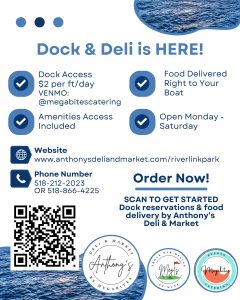
2025 ERIE CANAL AND HUDSON RIVER TOUR!
Coinciding with the 200th Anniversary of the opening of the Erie Canal, Flotsam River Circus will be traveling the entire length of the canal and the Hudson River, giving performances in dozens of towns from Buffalo to New York City.
Aug 1 – BUFFALO – Wilkeson Pointe Beach – 7 pm
Aug 2 – BUFFALO – Wilkeson Pointe Beach – 7 pm
Aug 3 – BUFFALO – Wilkeson Pointe Beach – 7 pm
Aug 4 – TONAWANDA – Gateway Harbor – 7 pm
Aug 5 – LOCKPORT – Wide Waters Marina – 7 pm
Aug 6 – MEDINA – Medina Canal Basin – 7 pm
Aug 7 – BROCKPORT – Harvester Park – 6:30 pm
Aug 8 – ROCHESTER – Corn Hill Landing – 7 pm
Aug 9 – ROCHESTER – Corn Hill Landing – 7 pm
Aug 10 – FAIRPORT – Lift Bridge West Dock – 7 pm
Aug 13 – GENEVA – Finger Lakes Welcome Center – 7 pm
Aug 14 – SENECA FALLS – Bonafiglia Foundation Property – 7 pm
Aug 15 – BALDWINSVILLE – Marble Island – 7 pm
Aug 16 – SYRACUSE AREA – Willow Bay Park – 7 pm
Aug 17 – LIVERPOOL – Onondaga Lake Park – 7 pm
Aug 19 – OSWEGO – Oswego Canal Lock 8 – 7 pm
Aug 20 – PHOENIX – Henley Park – 7 pm
Aug 21 – BREWERTON – Riverfront Park – 7 pm
Aug 22 – SYLVAN BEACH – Location TBA – 6:30 pm
Aug 23 – ROME – Bellamy Harbor – 6:30 pm
Aug 24 – FRANKFORT – Frankfort Marina – 6:30 pm
Aug 26 – CANAJOHARIE – Riverfront Park – 6:30 pm
Aug 27 – AMSTERDAM – Riverlink Park – 6:30 pm
Aug 28 – SCHENECTADY – Gateway Landing Park – 6:30 pm
Aug 29 – WATERFORD – Lock 2 Park – 6:30 pm
Aug 30/31 – CAPITAL DISTRICT – Location TBA – 6:30 pm
Sept 1 – HUDSON, NY – Henry Hudson Riverfront Park – 6:30 pm
Sept 2 – SAUGERTIES – Tina Chorvas Waterfront Park – 6:30 pm
Sept 3 – KINGSTON – Kingston Point Beach – 6:30 pm
Sept 4 – POUGHKEEPSIE – Kaal Rock Park – 6 pm
Sept 5 – BEACON – Long Dock Park – 6 pm
Sept 6 – HAVERSTRAW – Emeline Park – 6 pm
Sepy 7 – NYACK – Memorial Park – 6 pm
Sept 9 – HOBOKEN, NJ – Hoboken Cove
Sept 10 – NEW YORK CITY
Sept 11 – NEW YORK CITY
Sept 12 – NEW YORK CITY – Brooklyn Bridge Park
Sept 13 – NEW YORK CITY
Sept 14 – NEW YORK CITY
We are still nailing down a few locations – keep checking back.
All shows are for all ages and free to attend.
Donations keep us afloat!
WHAT IS FLOTSAM RIVER CIRCUS?
Flotsam is a troupe of musicians, circus performers, and puppeteers who travel on a ramshackle raft giving free performances in waterfront towns. Our goal is to bring some magic and whimsy to the world while helping communities engage with their waterways. Flotsam is a 501(c)(3) non-profit.
WE’RE LOOKING FOR HELP:
If you live anywhere along this route, we’d love to hear from you: [email protected]
Flotsam exists with your support. If you’d like to help keep us afloat, you can Venmo us at ‘rivercircus’ or donate HERE.
 Docking and dining in Amsterdam, just got a lot easier. Pay for docking and order food from Anthony’s deli and market.
Docking and dining in Amsterdam, just got a lot easier. Pay for docking and order food from Anthony’s deli and market. 








